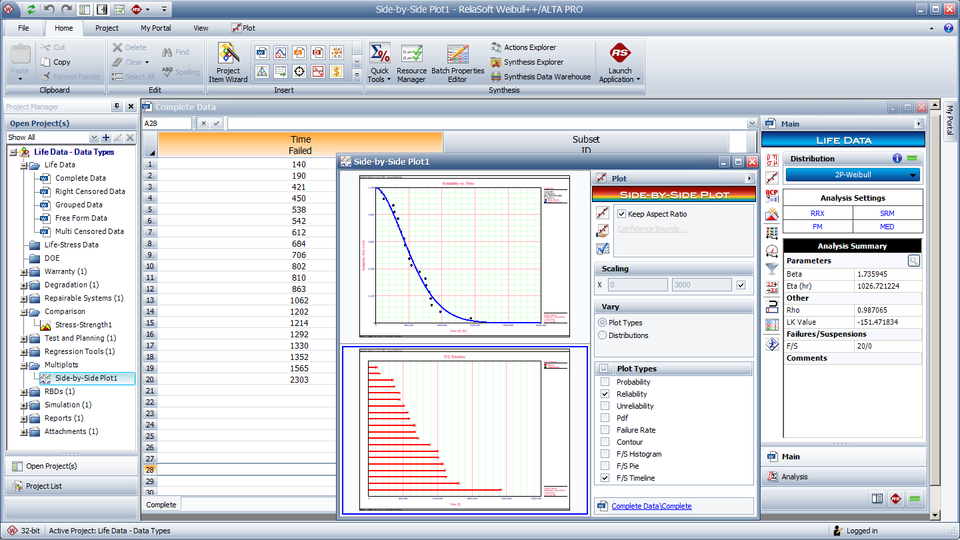

ReliaSoft's Weibull++ software tool is the industry standard for life data analysis worldwide. The software utilises multiple lifetime distributions (including all forms of the Weibull distribution), with a clear and concise interface designed specifically for reliability engineering.
ReliaSoft Weibull++ is the industry standard in life data analysis (Weibull analysis) for thousands of companies worldwide. Weibull++ provides the most comprehensive toolset available for reliability life data analysis, calculated results, plots and reporting.
The software supports all data types and all commonly used product lifetime distributions. The software is also packed with tools for related reliability analyses, such as warranty data analysis, degradation data analysis, non-parametric data analysis, recurrent event data analysis, reliability test design and experiment design & analysis (DOE).
- Supports all types of life data, including complete, right censored (suspended), left censored, interval censored and free-form data, entered individually or in groups.
- Includes all major lifetime distributions (including the Weibull model and the mixed Weibull model as well as the Exponential, Lognormal, Normal, Generalized Gamma, Gamma, Logistic, Loglogistic, Gumbel, Bayesian-Weibull and Competing Failure Modes). A distribution wizard will help you select the one with the best fit for a particular data set.
- Flexible results, plots and reports to quickly provide the results, plots and reports you need to support decisions based on analysis results and two template-based reporting tools that incorporate results based on the data analysis along with your own custom calculations.
Benefits
- Compare suppliers or designs based on reliability.
- Use data-driven analysis to address today’s demanding performance specifications.
- Demonstrate that an item meets specified reliability.
- Make predictions about performance during the useful life (or warranty) period.
- Use plots and other reports to effectively communicate performance estimates to management.
Capabilities
Life Data Types
- Complete (Failure Time)
- Right Censored (Suspension Time)
- Left Censored
- Interval Censored
- Free-Form
Distributions and Parameter Estimation
The software provides a choice of all major lifetime distributions (including all forms of the Weibull distribution).
- Weibull
- Normal and Lognormal
- Exponential
- Gamma and Generalized Gamma
- Logistic and Loglogistic
- Gumbel
- Bayesian-Weibull
- Mixed Weibull
- Competing Failure Modes (CFM)
Parameter estimation options for standard life data analysis include:
- Rank Regression on X (RRX)
- Rank Regression on Y (RRY)
- Maximum Likelihood Estimation (MLE)
- Non-Linear Rank Regression
- Fractional Failure Analysis
Distribution Wizard and Ranking Methods
If you are not sure which model is appropriate for a given data set, the convenient Distribution Wizard automatically performs several types of goodness-of-fit tests (Kolmogorov-Smirnov, Correlation Coefficient, Likelihood value) in order to rank the available distributions.
The tool also comes with the ability to rank data points using Kaplan-Meier or Median Ranks.
Confidence Bounds
Weibull++ also provides confidence bounds for parameters, calculated results and plots. Depending on the specific analysis method used, the confidence bounds may be calculated using the Fisher Matrix, Likelihood Ratio, Beta Binomial or Bayesian (BSN) approach.
Reliability Test Design
- Reliability demonstration test design: Determines the appropriate sample size, test duration or other variables for designing effective reliability tests and demonstration tests.
- Expected failure times plot: Displays times-to-failure that you may expect to observe for a given reliability life test.
- Difference detection matrix: Allows you to detect the difference between the reliabilities of two separate designs.
Warranty Data Analysis
A choice of data entry formats for using sales/returns data to perform life data analysis and make warranty projections: nevada chart, times-to-failure, dates of failure or usage (e.g., mileage, cycles, etc.).
Degradation Data Analysis
Use the linear, exponential, power, logarithmic, Gompertz or Lloyd-Lipow models to extrapolate the failure times of a product based on its performance (degradation) over a period of time. Weibull++ also includes destructive degradation analysis and the option to create user-defined degradation models.
Design Of Experiments (DOE)
Weibull++ supports a variety of experiment design types, including factorial and fractional designs, Taguchi robust designs, response surface method designs and DOE based on product life, called reliability DOE.
Reliability Block Diagrams
The built-in diagram feature allows you to create reliability block diagrams (RBDs) using blocks that are linked to analyzed Weibull++ folios. This feature can be used to analyze complex competing failure modes or simple system reliability. You can even send RBDs built in Weibull++ to BlockSim. This process exports the blocks into a new BlockSim simulation diagram, allowing you to perform further analyses such as system maintainability, availability and related analyses.
Life Data Results, Plots and Results
The Quick Calculation Pad (QCP) is a “Calculation Log” that allows you to record the results from a series of different calculations and then copy/paste the information as needed.
The software also provides a complete array of calculated results and plots based on the analysis. For life data analysis, this includes:
- Reliability or probability of failure
- Conditional reliability or conditional probability of failure
- Reliable life (i.e., time for a given reliability, also called “warranty time”)
- BX% life (i.e., time for a given unreliability)
- Mean life
- Failure rate
- Probability plots and pdf plots
- Contour plots
- Failure/suspension histograms, pie charts or timelines
Weibull++ provides a complete array of advanced plotting tools. The Plot Setup allows you to completely customize the “look and feel” of plot graphics. You can save your plots in a variety of graphic file formats for use in other documents.
- Overlay Plots (aka Multi-Plots)
- Side-by-Side Plots
- RS Draw® Metafile Graphics Editor
- 3D Plots
Customizable reports: The Synthesis Workbook is a custom reporting tool that is built into Weibull++. It seamlessly integrates spreadsheet and word processing capabilities while enabling you to include calculated results and plots from your analysis.
Additional Features
- Repairable System Analysis: Use the General Renewal Process (GRP) model or the Mean Cumulative Function (MCF) to analyze recurrent event data.
- Non-Parametric Life Data Analysis: Use Kaplan-Meier, Simple Actuarial or Standard Actuarial techniques when analyzing incomplete data that does not fit any life distribution in a satisfactory way.
- Event Log Folio: Use the specialized Event Log Folio to convert system failure and repair data into times-to-failure and times-to-repair.
- Monte Carlo simulation: Automatically perform analyses on simulated data sets in order to investigate confidence bounds, testing scenarios and help solve many other reliability engineering questions.
- Optimum replacement time calculation: The ability to calculate the optimum replacement time provides a powerful opportunity to reduce a system’s maintenance costs while maximizing uptime. The new Maintenance Planning Tool generates a cost vs. time plot designed to help you determine the most cost-effective time to replace a system’s worn or failed components. The tool also offers an option to create preventive and/or inspection tasks for use in BlockSim simulation diagrams.
- Non-Linear Equation Fit Solver: Estimates the parameters of any user-defined non-linear equation. This gives you the flexibility to perform simple parameter estimation on statistical models other than the life distributions and life-stress relationship models available in standard folios. After you have solved the equation, the tool provides a plot to visualize how the data fit the function, and also makes it easy to calculate Y for any given X value.
- Non-Linear Equation Root Finder: Quickly solves for the root of any user-defined non-linear equation. This helps you eliminate some of the guesswork of solving for the value of the unknown variable that makes the function be as close to zero as possible.
- Quick Parameter Estimator: Estimates the parameters of a statistical model based on what you know about the behavior over time. The software will “translate” your answers into the inputs required to obtain the model parameters.
- Quick Statistical Reference: Frees you from tedious lookups in tables by quickly returning results for commonly used statistical functions. Results include Median Ranks, Chi-Squared Values, Cumulative Binomial Probability, and many more. There is also a Polynomial Interpolation Function that allows you to enter known data points and then calculate Y for any given X value.
What's New in Version 2019
Version independent locator links
ReliaSoft Locator Links created in Version 2019 or later do not include the software version information as part of the link. When you open a link, the software will attempt to connect to the database, regardless of the database’s version. If you attempt to open a standard database that was created in an earlier version, the software will automatically convert it to the latest version. If you attempt to open an enterprise database that was created in an earlier version, the software will display a message; you must then upgrade the enterprise database to the later version.
Importing and exporting plot settings
Now in Version 2019 you have the option to import and export plot settings to an XML file. This allows you to define the settings for one plot and then use them in other plots.
Copy plot data
You can export the data from a plot to the Clipboard so that you can paste it into another application. The information depends on the plot type and on the application you are using.
Warranty folio for time and usage
For folios that use the usage format, you can predict the number of failures based on the time and usage as well as the time. For example, for a vehicle with a 3-year/30,000 mile warranty, you can show the total number of warranty returns based on both values.
Inspection view for Nondestructive Degradation
Starting in Version 2019, we have introduced a new worksheet view for Nondestructive Degradation. You can now use the Inspection View with nondestructive folio data sheets. This view is more intuitively set up to allow for multiple entries for each unit in one row.





